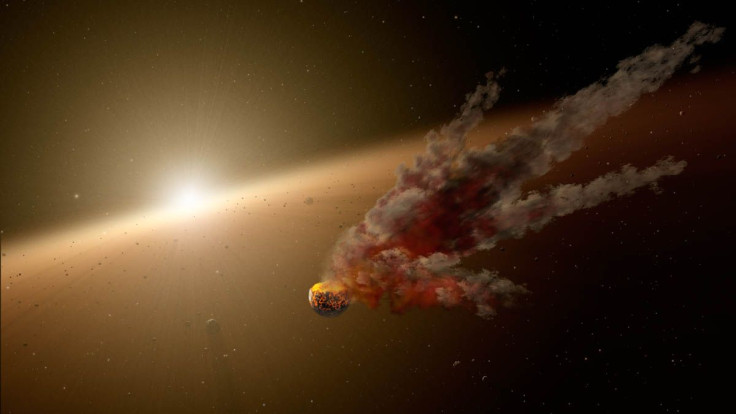NASA's Spitzer Spots Asteroid Smashup That Could Help Better Understand Planet Formation Process

NASA’s Spitzer Space Telescope has captured an eruption of dust around a young star, which astronomers believe to be the result of a collision between large asteroids. This type of collision has the potential to form Earthlike planets, according to scientists.
Although Spitzer has observed the dusty aftermaths of asteroid collisions before, this is the first time scientists have managed to collect data before and after a planetary-system smashup. Dubbed NGC 2547-ID8, the star had been regularly tracked by astronomers when it surged with a huge amount of fresh dust between August 2012 and January 2013, the scientists said in a study published in the journal Science Thursday.
“We think two big asteroids crashed into each other, creating a huge cloud of grains the size of very fine sand, which are now smashing themselves into smithereens and slowly leaking away from the star,” Huan Y.A. Meng, a graduate student at the University of Arizona at Tucson and the study’s lead author, said in a statement.
According to astronomers, dusty materials circling around a young star clump together to form asteroids that smash into each other. While the colliding asteroids are often destroyed, some grow over time and transform into proto-planets that evlove into full-grown, terrestrial planets after about 100 million years.
Previous observations of the star -- about 35 million years old and 1,200 light-years away from Earth -- recorded variations in the amount of dust around it, hinting at possible ongoing asteroid collisions. To witness an even larger impact, the astronomers later turned to Spitzer, which began focusing on the star in May 2012.
“We not only witnessed what appears to be the wreckage of a huge smashup, but have been able to track how it is changing -- the signal is fading as the cloud destroys itself by grinding its grains down so they escape from the star,” Kate Y.L. Su, an associate astronomer at the Steward Observatory at University of Arizona and a co-author of the study, said in the statement. “Spitzer is the best telescope for monitoring stars regularly and precisely for small changes in infrared light over months and even years.”
According to scientists, a very thick cloud of dusty debris now orbits the star in the zone where rocky planets typically form. As the scientists observe the star system, the infrared signal coming out from this cloud varies. By studying these infrared fluctuations, the scientists are gathering significant data on the detailed process and outcome of collisions that create rocky planets such as Earth.
“We are watching rocky-planet formation happen right in front of us,” said George H. Rieke, deputy director of the Steward Observatory at University of Arizona and a co-author of the study. “This is a unique chance to study this process in near real-time.”
© Copyright IBTimes 2025. All rights reserved.






















